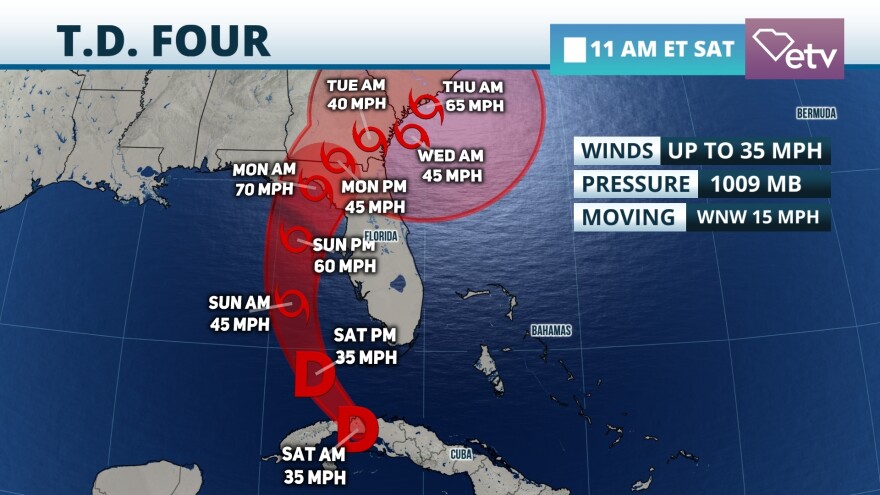

Late Saturday afternoon, the National Hurricane Center said that Tropical Depression Four had strengthened into a Tropical Storm Debby as it began moving northward through the Florida Keys.
At 5 p.m., maximum wind speeds with Debby were at 40 miles per hour and a Hurricane watch is in effect across the nature coast with Tropical Storm warnings in effect southward along the west coast of Florida, down through the Keys.
Tropical Depression 4 emerged over the Florida Straits on Saturday and, getting energy from the very warm waters of the Gulf of Mexico, morphed into Tropical Storm Debby, the fourth named storm for the 2024 season.
The track has shifted westward, with a more pronounced curve which keeps it over the warm waters a bit longer and gives it more time to become stronger.
It also delayed its landfall, and it is now expected to make landfall early on Monday morning in the Big Bend region, as a strong tropical storm or category 1 hurricane.
A hurricane watch is in effect for the Big Bend. This means hurricane conditions will start within the next 48 hours.
A tropical storm warning is in effect from Southwest Florida through the Tampa Bay area to Inglis.
FPREN is closely monitoring the speed of the system as it is showing signs of slowing as it approaches the Big Bend on Monday.
The speed on Saturday will stay steady but expect a gradual slowdown on Sunday and Monday, which will bring more frequent rounds of rain and storms over already saturated areas across north and central Florida from Sunday through Tuesday.
By Wednesday morning, the system could reemerge over water, this time in the eastern Atlantic by the South Carolina Coast.
It is likely to continue hugging the coast through Thursday, with its center over water, which means that it could gain strength and is likely to become a hurricane.
Water temperatures near the coast of the Carolinas are warm, between 82 and 86 degrees. This serves as prime fuel for this system to gain strength, and likely gain it quickly.

What can Florida expect?
Storm surge could be 3 to 5 feet, mainly in spots along the Big Bend. In the west central coast, including the Tampa Bay area storm surge could range between 2 and 4 feet, and in the southwest part of Florida between 1 and 3 feet.
This is still a soaker of a storm for Florida. Across South Florida, the last 24 hours have brought between 1 to 1.5 inches of rain across the Greater Miami region while some spots south of Naples have received 2 inches of isolated rain.
More rainbands are moving from southeast to northwest on Saturday as the system gets ready to exit Cuba. Expect the rainbands to continue to move northward and reach Central Florida by noon and in the middle of the afternoon the first rainbands should be reaching North Florida.
As the system moves over the Gulf of Mexico the rain bands will move from south to north then west to east as it makes the turn toward Florida.

Rainbands could drop high rainfall in a short amount of time, and there will be several of those so there is a high risk for flash flooding. Rivers and lake levels will be quickly rising and could flood rapidly too.
The highest rainfall is still expected over the west coast of Florida, from the southwest region through the Tampa Bay area, Big Bend, east of Tallahassee, and Jacksonville. There could be some spots that could have 10 inches of rain.
This is a large system so once the rain arrives in the northern portion of Central Florida and North Florida you can bet for it to continue through early next week.
Please avoid all flooded roads. Remember to turn around, don’t drown.
Another important aspect of the rainbands is that they can bring gusty winds (at least 60 mph) as there will be some embedded storms within the rainbands.
There could also be some rotation within the storms that could produce tornadoes. Please remain indoors, these tornadoes tend to form quick spin-ups and they can be dangerous and cause damage.
We will bring you updates here. You can expect a new story containing the latest information with each full bulletin issued by the National Hurricane Center at 11 a.m. and 5 p.m. and in between we will have updates on the latest story with any crucial information.
The FPREN team of meteorologists will also bring you updates on your local Public Radio station.

Tropical Storm Debby Discussion
NWS National Hurricane Center
The tropical cyclone has become better organized since the last advisory, with the circulation center becoming better defined over the southeastern Gulf of Mexico and areas of outer convective banding to the north and south of the central region. A combination of earlier scatterometer data, surface observations in the Florida Keys, and ship reports in the Straits of Florida shows an area of 30-35 kt winds located about 120 n mi from the center in the eastern semicircle. Based on this information, Tropical Depression Four is upgraded to Tropical Storm Debby.
The initial motion is now northwest or 310/13 kt. A large mid- to upper-level trough over the central United States is creating a break in the subtropical ridge, and Debby is expected to turn northward into this break in about 24 h.
This should be followed by a gradual turn toward the northeast at a slower forward speed through 60 h.
This motion should bring the center near or over the northern Gulf coast in roughly 48 h.
After landfall, weakening steering currents should cause the cyclone to slow down while it moves northeastward or eastward over parts of northern Florida and Georgia.
The uncertainty in the forecast increases significantly after 60 h as the cyclone interacts with a portion of the U.S. trough.
The latest GFS and ECMWF models show a slow eastward motion into the Atlantic, followed by a turn toward the north or northwest that brings the center back inland. On the other hand, the Canadian model is still forecasting Debby to move slowly northeastward across the southeastern states and does not bring it over the Atlantic.
This portion of the new forecast track continues to show a slow motion and leans toward the GFS/ECMWF solutions.
Conditions are favorable for strengthening over the Gulf of Mexico with warm sea surface temperatures and light shear. Intensification is likely to be slow during the first 12-24 h, then proceed at a faster rate after the cyclone develops an organized inner core.
The new intensity forecast calls for a peak intensity of 65 kt at landfall on the Gulf coast of Florida in best agreement with the HWRF model. Weakening is forecast after landfall while the system moves over the southeastern United States. B
eyond 72 h, the intensity forecast remains quite uncertain due to the possibility of land interaction and how much interaction will occur with the aforementioned mid-latitude trough.
Key Messages:
1. Heavy rainfall will likely result in considerable flash and urban flooding across portions of Florida and the coastal areas of the Southeast this weekend through Thursday. Significant river flooding is also expected.
2. Hurricane conditions are expected on Monday along portions of the Florida Big Bend region where a Hurricane Warning is in effect, with tropical storm conditions beginning late Sunday. Tropical storm conditions are expected through Monday farther south within the Tropical Storm Warning along Florida's west coast, including the Tampa Bay area and the Lower Florida Keys.
3. There is a danger of life-threatening storm surge inundation along portions of the Gulf coast of Florida from Aripeka to Indian Pass. Life-threatening storm surge is possible south of Aripeka to Bonita Beach, including Tampa Bay and Charlotte Harbor.
4. Impacts from storm surge, strong winds, and heavy rains are possible elsewhere in Florida and along the southeast coast of the United States from Georgia to North Carolina through the middle of next week, and interests in those areas should continue to monitor the progress of this system. Additional watches and warnings will likely be required tonight or on Sunday.
Copyright 2024 Storm Center . The National Hurricane Center contributed to this report.







